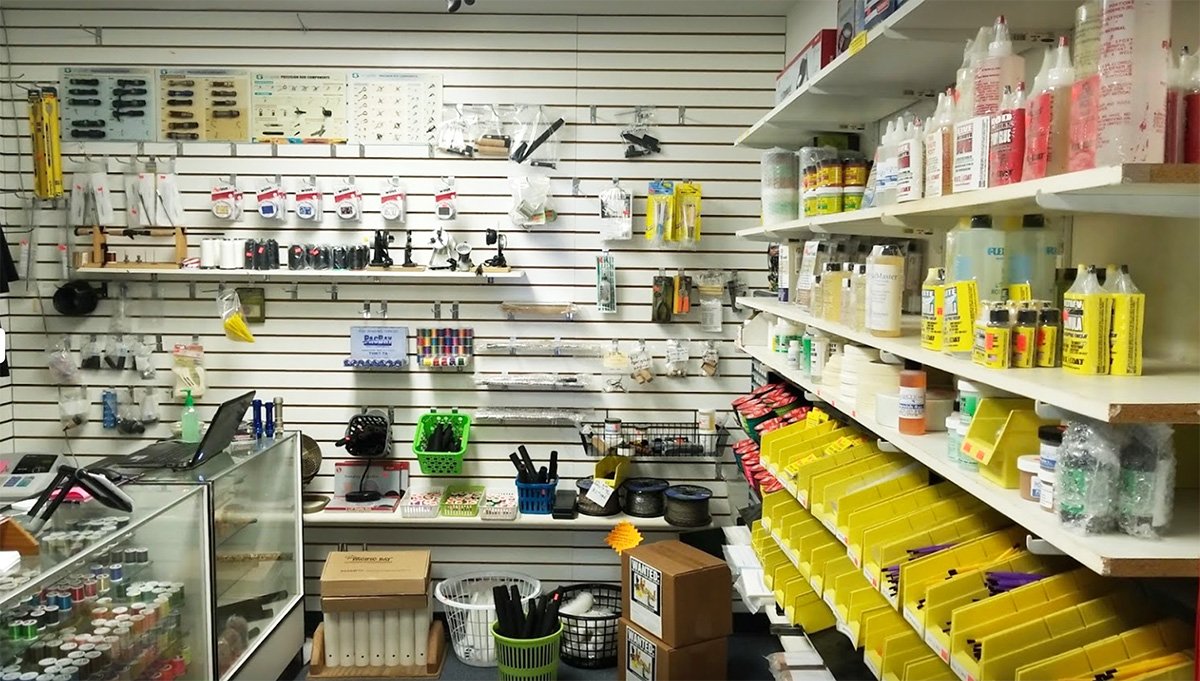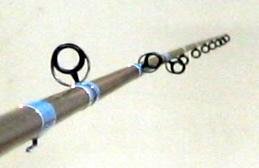Since 2004, C&M Custom Tackle, and online at Acidrod.com have been providing hobbyists, advanced rod builders, and professionals, the blanks, equipment, and components they need to build a custom fishing rod.
Trying to repair some of our fishing rods, product was coming mail order from a different coast and we thought, we can do this here. Our business grew so fast that within 6 months of it’s inception, we moved from ebay, to a walk in store, which was a requirement at that time to be able to purchase from almost all manufacturers!
We continue to try and supply everyone with quality customer service, knowledge and eagerness to help you with your needs on a daily basis. We are a mom-and-pop shop! We do not run our place like the big box stores. We will always let you know if we are out of something to allow you to make another choice if you desire to. We will help you in any way we can and if we do not carry something you’re after, we will do our best to send you where you can!
As things continue to change, so will we. We will continue to supply you with the what we think are the best products for your build. Thank you for shopping at C&M Custom Tackle, and online at Acidrod.com
Our shop in San Dimas, Ca for over 20 years, moved to Glendora, Ca 6/2025 !
We Proudly Support the Following Organizations
About Us
What is an Acidrod?
An Acid Rod or "Spiral Wrapped Rod" is a conventional or casting rod who's guides start out on top of the blank and then rotate around the rod leaving the final guides and tip under the blank. In a nutshell, this guide placement reduces torque allowing you to fight larger fish on lighter tackle with less fatigue.
Under load, conventional "top guide" rods have a natural tendency to twist or torque, trying to turn the tip downward. While few have ever had a rod flip over in their hand during a fight, many HAVE felt the fatigue of a long fight with a large fish due to their "death grip" on their rod. Not many even realize how hard they're squeezing their grip while fighting a "big one". That's just what a big fish does... It tries to rip the rod from your hands!
Those who trade off the line twist associated with spinning reels for their cast ability and "ease of use" don't feel that twisting that we die hard conventional rod users do. With the tip and guides on the bottom of their blanks, they have a more stable fishing platform than we do.
You'll also notice that a heavy 7' spinning rod often has fewer guides than a conventional rod of the same size. This is because with their guides UNDER the blank, they don't need nearly as many guides to keep the line OFF of the blank. Picture a 7' conventional rod fully loaded. It has to have at LEAST eight guides to keep the line from touching the blank. The same size spinning rod on the other hand, could do the same job with six to seven guides while still evenly distributing the load on the blank. More importantly, guides under the blank can be smaller, lighter and sit closer to the blank as they don't need ring height to keep the line up off the blank. A "guides on top" conventional casting rod needs a taller, usually much heavier "double Foot" guide to keep the line up off the blank when it's loaded.
Less guides are better? In most ways, the answer is YES. Fewer guides mean less weight over the length of the blank, especially the tip section. Less weight added to the blank makes a more sensitive, more responsive rod. You still need enough guides under the rod to distribute the load evenly and maximize the blank's available power. On a 7' rod, this can normally be done with one less guide if Spiral Wrapped rather than wrapped "guides on top". Combine that weight savings with the weight saved by not having to use a heavier "Double Foot" and you've saved a considerable amount of weight. Believe it or not, a weight savings of only a couple of grams can make a big difference.
My first experience with an Acid Rod came by way of a Marina operator on Upper Twin Lake in Bridgeport California. We were deep trolling for Brown Trout using both lead line and down riggers. With about ten "colors' out on one of my rods, the rod suddenly flipped upside down and slid out of it's rod holder, turning into a fading 'blip" on the depth finders. "Buh-bye".
I still had that "look" on my face as i was pulling the boat out of the water that afternoon. The Old Man running the marina took one look at me and said "the fish won today, huh?". I explained my agitated look telling him what had happened and how I'd lost a favorite reel that I worked all summer for to buy as a teen. He looked into my boat, picked up one of my two piece rods and twisted the top half 180 degrees, saying "try that". Had he not looked like a seventy five year old cross between a Drill Sergeant and a Woodshop Teacher, I might have suggested HE was on acid! He tried to explain "the tip should face down" theory to me and I politely listened (or pretended to).
After I launched the next morning and we started to drop our trolling spread, I got to the rod that the old boy had turned around. Thinking "what the hell', I left the top half turned around and started dropping line. I was so amazed at the different feel that the rod had, I just kept dropping line and soon felt the knot from the Dacron backer bumping it's way through the guides. Twelve colors (120 yards) of lead core out, and no twist what so ever. The rod sat perfectly stable in the cheap clamp-on rod holder.
I saw the old boy again that afternoon on the ramp. I kind of chuckled, telling him "you were right about that tip down thing". He just nodded with an "I told ya so" look on his face. As I was tying the boat down to the
trailer, he came out of the Tackle Shop carrying what looked like a 9' Salmon rod. He said, "I hate coffee grinders (spinning reels) but their rods work better. I've been wrapping mine half and half for years",
showing me the spiral wrap on the rod.
Time passed and I more or less forgot all about it until years later at a Fishing Show, when I watched as a custom rod builder pitched his spiral wrapped rods to a perspective client. The builder took what looked to
be a 30lb casting rod and placed the butt into a set of bearings that he had installed in a fixture, holding the rod at a 45 degree angle to the floor. He then tied off the line to a desk and began cranking on the reel,
loading the blank. When the blank began to load, it flipped over in the bearings. EVERY TIME. Just to make sure I wasn't seeing slight of hand, I asked if I could try it. This wasn't smoke and mirrors, it WORKED.
I couldn't build one for myself fast enough after that! One fish on that rod and I was hooked for life. Though they've been around since the early 1900's, not many fisherman have seen, let alone tried an AcidRod until recently. With companies such as All American Roller Guides recognizing the advantages of spiral guide placement and developing products FOR it, the Acid Rod's popularity is on the rise.
Acid Wrap -
"Another term for the spiral wrap. The term originated on the West Coast when one proponent of the wrap "Jim Racela" was said to have been on "acid" when he wrapped his rod in spiral fashion."
Spiral Wrap -
"A method for taking the line to the bottom of the rod on conventional casting type rods. Results in a rod which will not twist under load and is inherently stable."
Robert's Wrap -
"Another term for the spiral wrap named after rod builder Chuck Roberts, another proponent of spiral wrapping for casting rods."
I couldn't build one for myself fast enough after that! One fish on that rod and I was hooked for life. Though they've been around since the early 1900's, not many fisherman have seen, let alone tried an AcidRod until recently. With companies such as All American Roller Guides recognizing the advantages of spiral guide placement and developing products FOR it, the Acid Rod's popularity is on the rise.
Ten years ago, not many Custom Rod Builders had heard of an Acid Rod or Spiral Wrapped Rod, let alone seen one. That's not the case anymore, however only a small percentage of "professionals" have educated
themselves on the process. This group of Professionals stays on the cutting edge of new materials, new technologies, new techniques, etc... They are well traveled, well read, open minded "industry leaders", and I
honestly can't think of a single one that doesn't use or offer a Spiral Wrap in some if not all of their Conventional Rod Applications.
What does your local Tackle Shop/Rod Builder say? Some will honestly tell you that they haven't heard of it, or don't know much about it. However a VERY common reply from Builders unfamiliar with the Spiral
Wrap when asked if they can build it is, "I don't build those because they don't work", or more commonly, "I don't build those because they don't cast as well". Chances are, these builders haven't educated themselves on the process of Spiral Wrapping and simply find it easier to tell you that it doesn't work than to spend some time studying the process. Why? Because they're lazy and you'll believe them! After all, who's the "Professional Builder" and who's the Fisherman here?
Ask this same "Pro" if he has a preference between a "Simple Spiral" and a "Revolver Spiral" on a given blank. Chances are, he'll just get mad at this point because he hasn't a clue. Ask that same question of any of the top ten "Pro's" in the world and you'll more than likely get very strong opinions on exactly why one or the other is better suited for the application. Top Ten in the World VS. Local Tackle guy's opinion. You
decide.
Further reading, testing, building instructions and Rod "recipes" can be found using the links on the top right side of this page in Yellow type. Using the archives on many of the Internet's Rod Building Forums will
turn up more reading and information than you probably have time for! Use their search features to search "Acid Rod", "Acid Wrap" or "Spiral Wrap". Any question or doubt that you may have on the subject has
more than likely been asked and answered there several hundred times!






